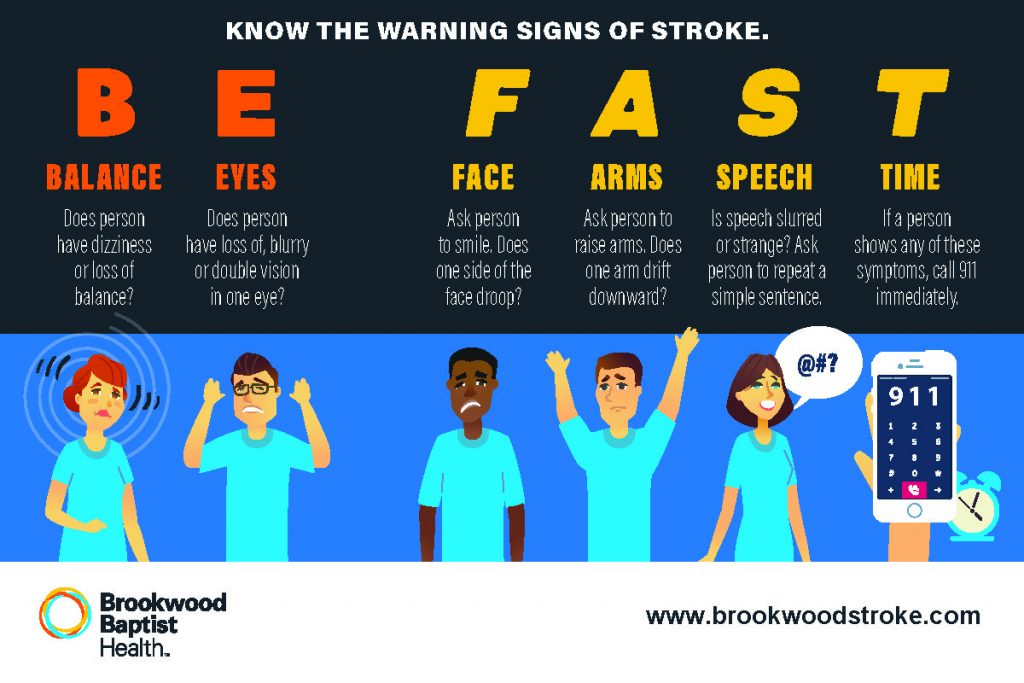By Bruce Burns, MD
Approximately every 40 seconds someone in the United States has a stroke and roughly every four minutes someone dies of a stroke. It causes about one in 20 deaths annually – making it the fifth-leading cause of death – and a leading cause of long-term disability. Alabama has the second-highest stroke mortality rate in the U.S., behind the State of Mississippi, according to the Centers for Disease Control and Prevention (CDC).
This high incidence of stroke earned Alabama a firm spot in “the stroke belt”; a name given to an 11-state region in the southeastern U.S. that has been recognized by public health authorities for having an unusually high incidence of stroke and other forms of cardiovascular disease.
According to the Heart Attack and Stroke Prevention Center, the risk of stroke is 34 percent higher for those living in the stroke belt than it is in other areas of the country. This staggering statistic underscores the importance of Stroke Awareness Month in our community, to include not only recognizing the signs of stroke, but also the importance of stroke prevention education.
If you are from the stroke belt, if you live in the stroke belt or if you have a strong family history of stroke, that doesn’t mean that you should expect to have a stroke in your lifetime. There are a number of things you can do to reduce your chances of having a stroke, even if you fall into a ‘high risk’ category, including the following:
Blood Pressure
The most important risk factor for stroke is high blood pressure, or hypertension. If left untreated, this condition can damage blood vessels throughout the body, causing them to narrow and clog more easily or weaken them so they could burst resulting in internal bleeding. When blood vessels in the brain become blocked or break and then leak blood into the brain, brain cells begin to die and the brain is not able to function properly. In addition to stroke, high blood pressure also can cause other forms of brain damage including dementia and memory loss.
In addition to being the leading cause of stroke, high blood pressure can cause heart failure, coronary artery disease, kidney failure and eye blood vessel damage. It has also been linked to sexual dysfunction, bone loss and trouble sleeping.
Smoking
Smoking is one of the most impactful ways to damage your body and your brain. Smoking leads to serious damage of the blood vessels in your brain and in your heart, which raises your risk of stroke.
Weight
Obesity is another stroke risk factor. While weight loss is among the most challenging lifestyle issues a person may face, even a little progress toward a healthy weight can have a substantial impact by reducing your chances of having a stroke.
Diet
That Southern dietary eating style is a hard habit to break. However, even small changes in dietary habits can make a big difference. For example, by limiting your intake of fried foods, you reduce your intake of trans fats, which can make a substantial difference in your stroke risk. Substituting some processed foods with fresh fruit and vegetables, which are rich in antioxidants, can help protect your body from damage.
Exercise
Exercise has been proven to prevent stroke. The key is to initiate some form of physical activity on a regular basis and increase those physical activities over time to reduce your chances of having a stroke.
Stress
High stress working situations are associated with increased stroke risk. Job security, long work hours, job stress and unpredictable work schedules can heavily impact your health. The vast majority of people are able to lessen stress and improve their quality of life with deliberate attention to stress reduction, including techniques such as relaxation and meditation, as well as spirituality and positive relationships, which have all been proven to reduce the risk of stroke.
Overall, the U.S. stroke belt is a real thing, but even if you live in Alabama or another state within the stroke belt, you can take action now to reduce your risk of stroke. If you have health issues or lifestyle issues that put you in danger of having a stroke, taking small steps toward stroke prevention can increase your life expectancy. And be sure to consult with your physician on a regular basis.
In addition to taking proactive steps to help reduce your risk of stroke, it is critical that you recognize the signs of stroke and seek emergency medical help right away. Early medical intervention significantly affects patient outcome, and treatment should be started in the closest emergency department as quickly as possible within the first three hours of the onset of symptoms.
Remember the following – BE FAST:
B: Balance – Does the person have dizziness or loss of balance?
E: Eyes – Does the person have loss of, blurry or double vision in one eye?
F: Face – Ask the person to smile. Does one side of the face droop?
A: Arms – Ask the person to raise their arms. Does one arm drift downward?
S : Speech – Ask the person to repeat a simple sentence. Is the person’s speech slurred or strange?
T: Time – If the person shows any of these signs, call 911 immediately.

Bruce Burns, MD, Chairman, Department of Emergency Medicine Princeton Baptist Medical Center





